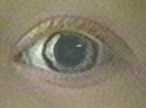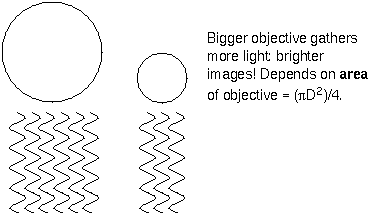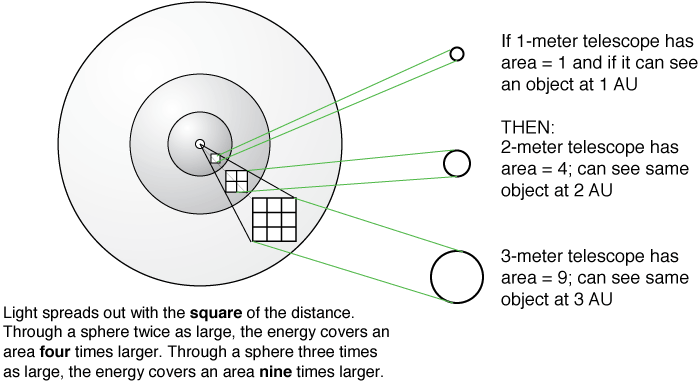 |
 |
Video lecture for this chapter
There are three features of a telescope that enable them to extend the power of our vision: a telescope's superior light-gathering ability enables us to see faint objects, a telescope's superior resolving power enables us to see even the tiniest of details, and the magnification power enables us to enlarge tiny images. Department stores and camera shops which do not know anything about telescopes, loudly proclaim their telescope's magnifying power. Magnification is the least important power of a telescope. Amateur and professional astronomers know that the light-gathering power and resolving power are the most important. These two abilities depend critically on the objective, so they make sure the optics of the objective are excellent.
 |
 |
The area of the objective is the determining factor. Since
most telescope objectives are circular, the area = ![]() × (diameter of objective)2/4,
where the value of
× (diameter of objective)2/4,
where the value of ![]() is approximately
3.1416. To compare light-gathering powers of two telescopes, you divide the area of one telescope by the area of the other telescope. For example: a 40-centimeter mirror has four times the
light-gathering power as a 20-centimeter mirror:
[(
is approximately
3.1416. To compare light-gathering powers of two telescopes, you divide the area of one telescope by the area of the other telescope. For example: a 40-centimeter mirror has four times the
light-gathering power as a 20-centimeter mirror:
[(![]() 402/4) /
(
402/4) /
(![]() 202/4) = (40/20)2 = 4].
202/4) = (40/20)2 = 4].

The light from a glowing object becomes more dilute as it spreads out from the object in a predictable way. The light covers larger and larger concentric spheres centered on the object, so that the object appears dimmer with the square of the distance. An object will appear four times dimmer when it is twice as far away, it will appear nine times dimmer when it is three times as far away, etc. Since the light-gathering power depends on the square of the diameter of the objective, the distance that an object can be detected increases as just the diameter of the objective (no square). To compare how much farther one telescope can detect an object than another telescope, you divide the diameter of one telescope by the diameter of the other telescope. Some examples are given in the figure below. Consider another example of how much farther one could see with the 10-meter Keck telescope than with the human eye. The largest the pupil of the eye can dilate is 9 mm (for a young eye---older eyes do not dilate as much). So the Keck telescope at 10 meters x 1000 mm/meter = 10,000 mm across can see an object at least 10,000/9 = 1111 times farther away than with the unaided, dark-adapted eye for the same exposure time. For the human eye, the exposure time is about one-tenth of a second: that is the refresh rate of an image on the retina. Longer exposures enable a telescope to detect objects at even greater distances.

![]() Go back to previous section --
Go back to previous section --
![]() Go to next section
Go to next section
last updated: January 19, 2022